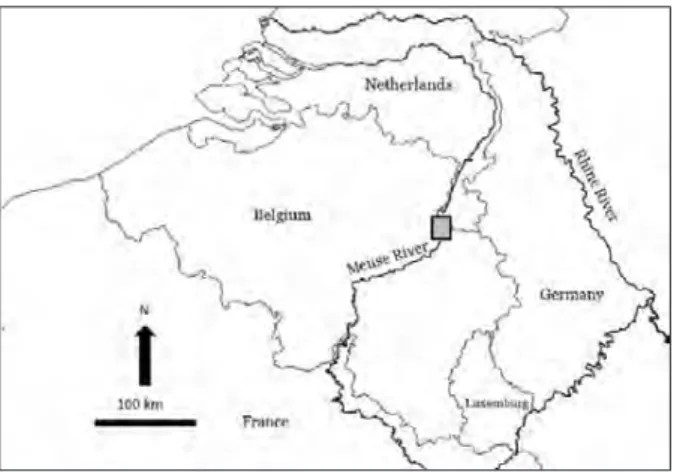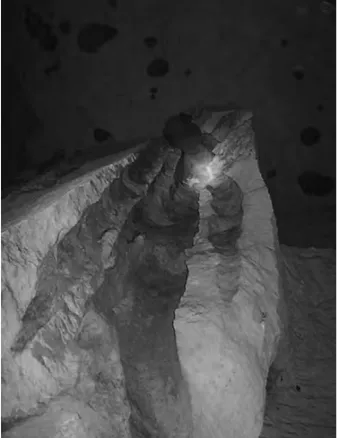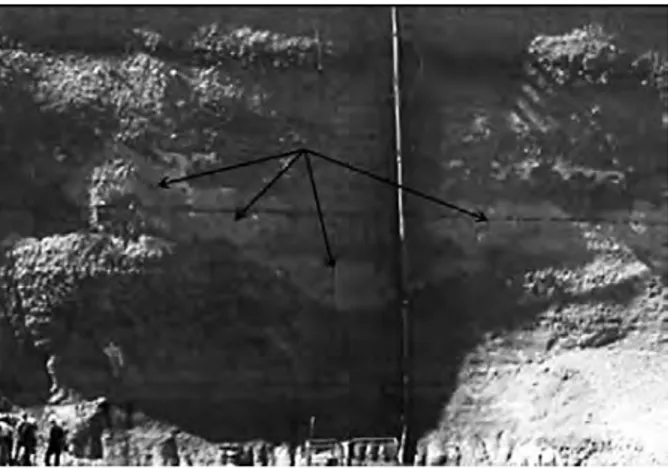Pure white chalk and impervious marls of Campanian age separate the exposed Maastrichtian carbonates from the underlying deeply weathered and kaolinized Carboniferous limestones (Felder and Bosch 1998). Above the Cretaceous layers, Oligocene marine sands were deposited. In some places these sands are preserved in dolines developed in the Cretaceous formations. During Pliocene time, the river Meuse drainage system came into existence and progressively incised down to its present level, as testified by peneplain surfaces and gravel terraces. The high terrace of the river is a Middle Pleistocene gravel formation. This coarse and loamy river deposits armour the underlying Cretaceous chalk and lead to a local relief inversion (Juvigné 1976). During the Weichselian glaciation, about
ENDOKARSTS AND CRYPTOKARSTS IN CRETACEOUS COARSE AND
HIGHLY POROUS CHALK AT THE BELGIAN-DUTCH BORDER
Luc Willems1, Joël Rodet21Department of Geology, Sedimentary Petrology, Bd du Rectorat, B20, Sart Tilman, 4000 Liège, Belgium.
L.Willems@ulg.ac.be
2 UMR 6143 CNRS, Morphodynamique continentale et côtière, Laboratory of Geology, University of Rouen, 76821
Mont-Saint-Aignan Cedex, FRANCE
Abstract. Since 2003, the study of several quarries at the Belgian-Dutch border has made it possible to identify numerous karsts essentially developed in coarse chalk (calcarenites) of the Maastricht Formation (Upper Cretaceous). This lithology is highly porous and is often considered unfavorable to karstification. However, caves, solution pipes, sponge networks, roof channel, pockets (alveoli) several meters in diameter developed inside without connection to fractures. These karsts belong to flooded karsts (caves and pockets) or to younger cryptokarsts (input karst type – thousands of solution pipes). When the endokarsts dewater, the high porosity of calcarenites inhibits closed caves from evolving. Tubular solution pipes are produced by the seepage water under fluvial terrace gravels and can exceed 30 m deep under the surface plateau. Sometimes, they encounter caves which are consequently filled and fossilized. By this process, they preserve caves from further collapsing inside a crumbly lithology.
Abstrait. Depuis 2003, l’étude de différentes carrières, à la frontière belgo-néerlandaise, a permis d’identifier un grand nombre de karsts essentiellement localisées dans des calcarénites de la Formation de Maastricht (Crétacé supérieur). Cette lithologie très poreuse est souvent considérée peu karstifiable car elle devrait inhiber une concentration des altérations. Pourtant, grottes, racines du manteau d’altération, réseaux en éponge, chenaux de voûte, alvéoles plurimétriques y sont développés, hors fracturation. Ces morphologies sont rattachées soit à des endokarsts noyés (grottes, alvéoles) soit à des cryptokarsts plus récent de type « karsts d’introduction » (plusieurs milliers de racines du manteau d’altération). Au moment de l’exondation des endokarsts, la porosité élevée des calcarénites stoppe l’évolution des grottes fermées. Des racines du manteau d’altération, formes tubulaires générées par les eaux d’infiltration sous un cailloutis de terrasse fluviale, peuvent s’enfoncer de plusieurs dizaines de m sous la surface du plateau. Elles peuvent recouper des grottes qu’elles colmatent et qu’elles préservent d’effondrement ultérieur dans une lithologie très friable.
1. Introduction
Cretaceous chalks and calcarenites (coarse chalks) at the Belgo-Dutch border (Fig. 1) develop numerous endokarsts and cryptokarsts without connection with fractures and in spite of a high porosity of the rock (Willems et al. 2004, 2005a, b; 2007a, 2007b, 2010; Lagrou et al. 2008; Rodet et al. 2009b). These cryptokarsts are essentially vertical tubes, solution pipes, which can reach more than 30 m deep under the plateau surface. In the area, they take place only under fluvial terrace gravels. The endokarsts are centimeters to several meters in size closed pockets which can be organized in subhorizontal blind tunnel-like caves which can be more than 60 m long. These caves had functioned as drains in the top of an aquifer.
2. Physical environment
The studied karsts are intersected by underground or surface quarries opened in the Gulpen and Maastricht Formations (Cretaceous), exposed with a thickness of 100 m. The upper-lying Maastricht Formation consists in macroporous calcarenites rich in flint nodules and subdivided by hardgrounds. Porosity between 37 % and 44 % (Willems et al. 2010) is determined near cavities. These values are much reduced at hardgrounds or fossiliferous beds, which have no influence on the studied karst morphologies.
The underlying Gulpen Formation consists of very fine calcarenites grading downwards to chalk rich in flint beds.
Figure 1. Localization of the studied area.
Karst and Caves in Carbonate Rocks, Salt and Gypsum – oral 2013 ICS Proceedings
ten meters of loess was deposited, burying the pre-existing landscape (Haesaerts, 1984).
High rates of underground water flow (2.2 to 13 km/day) have been reported (Dassargues and Montjoie 1993). They are similar to highly karstified aquifer (Harold 1937; Atkinson and Smith 1974; Rodet 1992; Maurice et al. 2006). They could be due to horizontal narrow pipes observed in drainage galleries (Van Den Broeck et al. 1910; Ministère de la Région wallonne and Université de Liège 2006), but also to the caves and sponge networks found in the Maastricht Formation. Deep weathered nodes are also generated in chalks of the Gulpen Formation, tens of meters under the Meuse alluvial plain (Willems et al. 2007a, b; 2010). They could also favour high rates of flows.
3. Cryptokarsts
The cryptokarsts are essentially tubular solution pipes (raciness du manteaux d’altération) (Fig. 2) developed under terrace gravels of the river Meuse. They have quite regular sections and their diameters vary between a few centimeters to over two meters. They may exceed 30 m deep under the plateau surface. The solution pipes contain Oligocene sands and/or sandy clays, and also rounded pebbles coming from the upper Meuse river terrace. The descent of superficial deposits into the Cretaceous strata supports evidence of deepening of the solution pipes. Their widening results from the coalescence of smaller ones. Juvigné (1992) connected their genesis to lithological variation in terrace deposits. The coarse parts of the terraces produce local concentrations of seepage water and initiate these solution pipes (Rodet et al. 2009a). A local flint accumulation could trigger the same water concentration process. On the contrary, when sand deposits partially cover the Cretaceous formations, no evidence of solution pipes are found. The reason for this could be the dispersion of seepage water in this kind of lithology. Several observations show that these cryptokarsts stopped enlarging at around 75–80 ka BP, i.e. the Upper Weichselian (Juvigné 1992; Juvigné et al. 2008; Willems et al. 2010). Juvigné (1992) suggests a permafrost, which inhibited the seepage water. Another hypothesis is a fast loess deposit on the terrace gravel playing the same role as a sand cover (Willems et al. 2010). The rapidity of loess deposits is supported by a non-eroded tephra inside the loess. Some solution pipes encountered lower horizontal caves, their filling are withdrawn, and small swallow holes are generated (Willems et al. 2010).
4. Endokarsts
Most endokarsts consist of meters to several meters sized blind cavities with similar altitudes. They are located between 20 and 30 m below the plateau surface and between 10 and 20 m below the contact Oligocene/ Cretaceous (Willems et al. 2007, 2010). Two types of cavities can be identified: the first one consists in a corridor with an ellipsoidal section, developed in a parallel to the subhorizontal stratification. The second one is made of a single room with rounded walls, which are in turn generated
by the coalescence of many centimetric to decametric pockets. There is an obvious continuum between sponge networks, single-room caves, and corridor caves (Fig 3). Endokarsts have the following characteristics:
1. The caves are formed outside the fractures. If fractures are present, they are poorly karstified and they dissect the caves.
2. Numerous small horizontal pipes are connected to the main cave without a preferential orientation.
3. The cave floor is made of mixed collapsed blocks and weathered calcarenite powder. There is a transition between this powder and the fresh bedrock without a clear limit. Traces of oxide migrations inside the weathered part of the floor attest to slow water flows. In some cases, the cave floor consists in pockets.
4. Some corridor caves are completely clogged up by superficial deposits (Tertiary sands, loess) (Fig. 3c) and show sedimentary fill typical of low energy flow. These observations show that some caves had functioned as drain in the top of an aquifer.
5. Trace of an ice-wedge is observed in the floor deposit of a cave (Willems et al. 2010). It demonstrates the top of an old permafrost tens meters under the plateau surface. Figures of hydromorphy under this structure (traces of iron hydroxide remobilization) could result from a perched aquifer due to the impermeable permafrost. It could explain the temporary concentrated flows from the seepage water and promotes drains and a slow moving of the brecciated materials of the floor.
Figure 2. Solution pipes opened in the underground quarry (Caster, Belgium).
Karst and Caves in Carbonate Rocks, Salt and Gypsum – oral 2013 ICS Proceedings
5. Discussion – Conclusion
At least three stages are identified in evolution of the karsts: Firstly, the developments of caves, deep under the surface of the plateau, in phreatic zone, as evidenced by sponge networks, micro and macro pockets.
Secondly, a dewatering of the caves and a widespread terminated of dissolution process.
Thirdly, the development of fractures which dissect the caves or solution pipes which encounter them. In this stage, the caves can be completely filled and fossilized (Fig. 4). Various caves listed are sometimes several kilometers away from each other and have similar altitudes. Their genesis can be related to a paleo aquifer. The caves could also result in the evolution of deep weathering nodes (Fig. 5) such as those found twenty meters below the Meuse alluvial plain (Willems et al. 2007). These nodes are similar to “ghost-rocks” found within the Tournaisian limestone (Quinif et al. 1994; Vergari 1998). The ghost-rock is “in situ” limestone weathering with residual weathered-rock (“ghost-rock”) that keeps its initial volume.
The caves could be related to slow water circulations within the Cretaceous Formations and under the regional thalwegs (Willems et al. 2007 a, b) The dismantling of this paleo aquifer can be due to the downcutting of the Meuse River and its tributaries.
Studies of karst in high porosity carbonate rocks are still few (Rodet 1992). However, the example of the Cretaceous chalk karstification at the Belgian-Dutch border shows that they can be very numerous. Their genesis results of a much more complex history than a simple fracture karstification. Their impact on water resources needs to be evaluated.
References
Atkinsons C, Smith DI, 1974. Rapid groundwater flow in fissures in the Chalk: An example from South Hampshire. Quarterly Journal of Engineering Geology, 7: 197–205.
Dassargues A, Monjoie A, 1993. Hydrogeology of the chalk of North-West Europe. Chap. 8: Chalk as an aquifer in Belgium, Oxford University Press, 153–169.
6. Some caves are encounter by solution pipes. The superficial materials (loess, terrace pebbles, etc.) which constitue the central part of the solution pipe partially dump in the caves. The deposit shows evidence of a process in an unsaturated zone. It shows that the cave was dewatered before it was encountured by solution pipes.
Figure 3. Several types of endokarsts: a.) sponge network inside the calcarenite – Petit Lanaye Supérieur (scale bar: 20 cm); b). single room cave – Petit Lanaye Supérieur; c). corridor cave with Tertiary sands and Quaternary loess filling – CRSOA cave – Petit Lanaye inférieur – Belgium (scale bar: 20 cm).
Figure 4. Complex karst network in the quarry of Romont-Belgium. Horizontal corridor cave (G) – single room caves(A) encountered by solution pipes (R) which intersect previous forms.
Karst and Caves in Carbonate Rocks, Salt and Gypsum – oral 2013 ICS Proceedings
Felder WM, Bosch PW, 1998. Geologie van de St. Pietersbergbij Maastricht. Grondboor & Hamer, 52: 53–63.
Haesaerts P, 1984. Aspects de l’évolution du paysage et de l’environnement en Belgique au Quaternaire, in: Cahen, D., Haesaerts, P. (Eds.), Peuples chasseurs de la Belgique préhistorique dans leur cadre naturel, Bruxelles, 27–39. Harold C, 1937. The flow and bacteriology of underground water
in the Lee Valley. Metropolitan Water Board 32nd Annual Report, London, England. 89–99, in Maurice et al. 2006. Juvigné E, 1976. La stratigraphie du Quaternaire. Géomorphologie
de la Belgique, in Hommage au Prof. P. Macar, Laboratoire de Géologie et Géographie physique, Université de Liège, 169–179.
Juvigné E, 1992. Les formations cénozoïques de la carrière C.B.R. du Romont (Eben/ Bassenge, Belgique). Ann. Soc. Géol. de Belgique, 115: 159–165.
Juvigné E, Tallier E, Haesaerts P, Pirson ST, 2008. Un nouveau stratotype du téphra de Rocourt dans la carrière de Romont (Eben/Bassenge, Belgique). Quaternaire, 19 (2), 2008, 133–139.
Maurice LD, Atkinson TC, Barker JA, Bloomfield JP, Farrant AR, Williams AT, 2006. Karsticbehaviour of groundwater in the English Chalk. J. of Hydrology, 330: 63–70.
Ministère de la Région wallonne (DGRNE) & Université de Liège, GéomacHydrogeologie, 2006. Carte hydrologique de Wallonie, Alleur-Liège 42/1-2,Notice explicative, 52.
Quinif Y, Vergari A, Doremus P, Hennebert M, Charlet JM, 1994. Phénomènes karstiques affectant le calcaire du Hainaut. Bull. Soc. Bel. de Géologie, 102: 379–384.
Rodet J, 1992. La craie et ses karsts, Caen, Centre normand d’Étude du Karst et des Cavités du Sous-sol. Elbeuf, & Groupe Seine-CNRS, 560.
Rodet J, Brown J, Dupont J-P, 2009a. Development and function of a perched aquifer in the covering layers of the chalk limestones in the Paris Basin. Proceedings of the 15th International Congress of Speleology, Kerrville (Texas, USA), 19–26 july 2009, UIS, vol. 3, contributed papers: 1662–1666. Rodet J, Willems L, Brown J, Ogier-Halm S, Bourdin M, Viard JP, 2009b. Morphodynamic incidences of the trepanning of the endokarst by solution pipes. Examples of chalk caves in Western Europe (France and Belgium). Proceedings of the 15th International Congress of Speleology, Kerrville (Texas, USA), 19–26 july 2009, UIS, vol. 3, contributed papers: 1657–1661. Speleogenesis, 2012. Info KarstBase Glossary of Karst and Cave Terms. www.speleogenesis.info/directory/glossary/index.php Van Den Broeck E, Martel EA, Rahir E, 1910. Les Cavernes et les
Rivières souterraines de la Belgique. Lamertin, Bruxelles, Vol. I, p. VIII.
Vergari A, 1998. Nouveau regard sur la spéléogenèse: le “pseudo-endokarst”duTournaisis (Hainaut, Belgique). Karstologia, 31/1: 12–18.
Willems L, Rodet J, Massei N, Fournier M, Laignel B, Dussart-Baptista L, Schyns JCH, Ek C, 2004. Chalk karsts – Saint-Pierre Mountain – Basse-Meuse (Belgium). Poster – Meuse-Rhine EuregioGeologists Meeting, Maastricht, 28–29 Mai 2004.
Willems L, Rodet J, Massei N, Fournier M, Laignel B, Dussart-Baptista L, Schyns JCH, EK C, 2005a. Genèse d’un système karstique dans la craie en Basse Meuse (Frontière belgo-néerlandaise). Poster, Coll. Intern. “Karst et aménagement du territoire “, Région wallonne, Jambes, Mai 2005.
Willems L, Rodet J, Fournier M, Massei N, Laignel B, Dussart-Baptista L, Schyns JCH, Dusar M, Lagrou D, Ek C, 2005b. Karst system genesis in the chalk of the lower Meuse (Belgian-Dutchborder)”, 14e Congrès de l’UIS, Athènes- Kalamos, 23–28 Août 2005, CDRom Full Paper: 0–36 (6 p).
Willems L, Rodet J, Fournier M, Laignel B, Dusar M, Lagrou D, Pouclet A, Massei N, Dussart-Baptista L, Compère PH, Ek C, 2007a. Polyphase karst system in Cretaceous chalk and calcarenite of the Belgian-Dutch border. Z.Geomorph. N.F., Berlin-Stuttgart, 51 (3): 361–376.
Willems, L., Rodet, J, Ek, C., Dusar, M., Lagrou, D., Fournier, M., Laignel, B. & Pouclet, A., 2007b. Karsts des craies et calcarénites de la Montagne Saint-Pierre (Basse Meuse liégeoise)”. Bull. des Chercheurs de la Wallonie, 46: 171–186. Willems L, Rodet J, Ek C, Pirson ST, Juvigné E, 2010. Karsts des calcarénites de la carrière du Romont (Eben – Belgique). Bull. Chercheurs de la Wallonie, hors-série No. 3, 115–130. Figure 5: deep weathering nodes – ENCI quarry –
Maastricht-Netherlands.
Karst and Caves in Carbonate Rocks, Salt and Gypsum – oral 2013 ICS Proceedings



